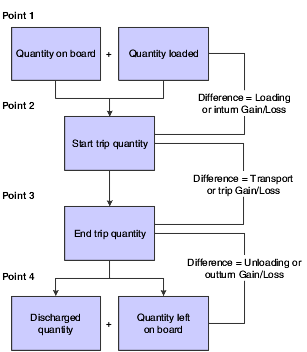Understanding Gain and Loss Calculations for Received Products
Use four-point analysis when you record received products to calculate any gains or losses that might have occurred during shipment. Four-point refers to the opening and closing readings at a supplying location, and the opening and closing readings at a receiving location. Analysis refers to the variance between the two results (that is, the gain or loss).
You can choose to perform a four-point analysis for each line item on a purchase order. You can also perform a four-point analysis on partial receipts. The program creates a four-point record for each receipt.
The data from a four-point analysis is informational only. It does not update the gain/loss table or the general ledger, and you cannot retrieve this data for other programs. If you need the output elsewhere, for example, to enter a gain or loss manually, print the form and enter the data in the required program.
If you receive an item that is set up for receipt routing, you can set a processing option in receipts entry to call the Four-Point Analysis program when product is routed to the payment eligible and on-hand steps.
This diagram illustrates a four-point analysis:

During four-point analysis, the system:
Adds the opening on-board quantity to the quantity loaded (Point 1) and compares the total to the start trip quantity (Point 2).
Any difference represents the loading (inturn) gain or loss. The system calculates a percentage based on the sum of opening on-board plus loaded quantities.
Compares the start trip quantity (Point 2) to the end trip quantity (Point 3).
Any difference represents the transport (trip) gain or loss. The system calculates a percentage based on the opening on-board quantity.
Compares the end trip quantity (Point 3) with the sum of the discharged (Point 4) and left-on-board quantities.
Any difference represents the unloading (outturn) gain or loss. The system calculates a percentage based on the end trip quantity.
Calculates the total gain or loss, both in volume and percent.